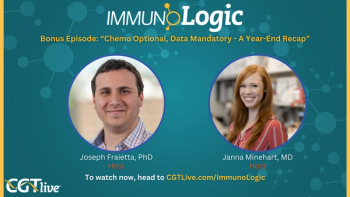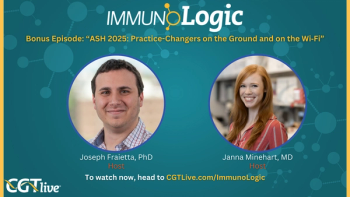
Frontline Axi-Cel Elicits 74% CR Rate in High-Risk Large B-Cell Lymphoma
Axicabtagene ciloleucel elicited a high objective response rate of 85%, with a complete response rate of 74% when used as a first-line therapy in patients with high-risk large B-cell lymphoma.
Axicabtagene ciloleucel (axi-cel; Yescarta) elicited a high objective response rate (ORR) of 85%, with a complete response (CR) rate of 74% when used as a first-line therapy in patients with high-risk large B-cell lymphoma (LBCL), according to updated data from the phase 2 ZUMA-12 trial (NCT03761056) presented during the
Additionally, the partial response rate was 11% with the product, while 15% of patients experienced stable disease (SD). Notably, at a median follow-up of 9.3 months, 70% of the 27 response-evaluable patients were found to have an ongoing response to treatment.
“ZUMA-12 is the first study evaluating CAR T-cell therapy as first-line therapy in [patients with] high-risk LBCL, defined by both histology and/or International Prognostic Index and dynamic risk assessment with PET scan,” Catherine Thieblemont, MD, PhD, head of the Hemato-Oncology Department at Hôpital Saint-Louis, said during a presentation of the data. “Axi-cel may be safety administered and demonstrates substantial clinical benefit in patients with an unmet medical need.”
Patients who have high-risk LBCL are known to have poor outcomes, including lower response rates and poorer OS.2 Notably, patients who experience early disease recurrence following frontline treatment with rituximab (Rituxan)-based chemoimmunotherapy are at an increased risk of death.3,4
In October 2017, the
The multicenter, open-label, single-arm ZUMA-12 trial enrolled patients with high-risk LBCL defined as high-grade BCL with MYC and BCL2 and/or BCL6 translocations or LBCL with an International Prognostic Index (IPI) score of 3 or higher any time prior to enrollment. Participants were treated with 2 cycles of an anti-CD20 monoclonal antibody plus an anthracycline-containing regimen. To be eligible for enrollment, patients had to be 18 years of age or older and have an ECOG performance status of either 0 or 1.
Patients underwent leukapheresis followed by potential nonchemotherapy bridging therapy, which was then followed by conditioning chemotherapy plus axi-cel infusion. The conditioning regimen comprised intravenous (IV) fludarabine at 30 mg/m2 plus IV cyclophosphamide at 500 mg/m2 on days -5, -4, and -3. Axi-cel was administered via a single IV infusion of 2 x 106 CAR T cells/kg on day 0.
The primary end point of the trial was CR per investigator assessment and Lugano classification, while key secondary end points comprised ORR, duration of response (DOR), event-free survival, progression-free survival (PFS), OS, safety, as well as CAR T cells in the blood and cytokine levels in serum.
A total of 37 patients were enrolled to the trial; 32 of these patients received conditioning chemotherapy and 32 were given the CAR T-cell product. Five patients did not receive axi-cel. The data cutoff was August 25, 2020, and the median follow-up time in the efficacy-evaluable patients was 9.3 months (range, 0.9-18), while the median follow-up time in the safety-evaluable patients (n = 32) was 9.5 months (range, 0.9-18).
Of the 32 patients who received axi-cel, the median age was 61 years, 72% were male, 88% had stage III/IV disease, and 66% had an ECOG performance status of 1. All patients had received at least 1 previous line of systemic treatment. Moreover, 72% of patients had an IPI score of 3 or higher at baseline.
Additional results from the trial presented during the meeting showed that the median time to initial objective response with axi-cel was 1.0 months (range, 0.9-3.1), while the median time to CR was also 1.0 months (range, 0.9-6.4). Fifteen percent of patients converted from a PR to a CR, while 4% converted from SD to a CR.
Notably, the median DOR, PFS, and OS had not yet been reached at a median follow-up of 9.3 months.
Moreover, a higher frequency of CCR7+CD45RA+ T cells in the pre-infusion product was linked with greater expansion of CAR T cells in the ZUMA-12 trial vs the ZUMA-1 trial, which could indicate improved T-cell fitness in frontline treatment, according to Thieblemont.
The median tumor burden was noted to be lower in ZUMA-12 vs cohort 1 of ZUMA-1, at 2091 mm2 vs 3684 mm2, respectively. Moreover, the median time to peak levels of CAR T cells in the blood was 8 days in the ZUMA-12 trial. Pharmacokinetic profiles proved to be comparable in patients with double- or triple-hit lymphoma and DLBCL with an IPI score of 3 or higher.
Regarding safety, any-grade treatment-emergent toxicities were reported in all patients who received axi-cel; 22% of these effects were grade 3, 56% were grade 4, and 3% were grade 5 in severity. The most frequently reported grade 3 or higher toxicities included encephalopathy (16%), increased alanine aminotransferase (9%), and decreased neutrophil count (9%). One grade 5 effect was reported, and this was noted to be due to COVID-19.
Any-grade cytokine release syndrome (CRS) was reported in all 32 patients evaluated for safety; this was grade 3 in 9% of patients. The most common any-grade symptoms of CRS included pyrexia (100%), chills (25%), and hypotension (25%). Fifty-three percent of patients received tocilizumab (Actemra) to manage the CRS, while 25% were given steroids. The median time to onset of CRS was 4 days, and the median duration of events was 6 days. All patients had their CRS resolve. Notably, no grade 4 or 5 CRS effects were observed.
Sixty-nine percent of patients experienced any-grade neurologic toxicity; in 25% of these patients, the effect was grade 3 in severity. The most frequently any-grade symptoms of these neurologic effects included encephalopathy (31%) and a confusional state (28%). Six percent of patients had grade 4 neurologic toxicities, but no grade 5 effects were reported. Thirty-four percent of patients received steroids to manage these toxicities. Here, the median time to onset was 9 days, while the median duration of events was 6 days. Ninety-one percent of patients had resolved events. The 2 unresolved events were grade 1 tremor and grade 1 memory impairment.
The median peak serum analytes linked with grade 3 or higher neurologic effects or CRS in ZUMA-12 proved to be consistent with previous data yielded from ZUMA-1, concluded Thieblemont.
References
- Neelapu SS, Dickinson M, Munoz J, et al. Interim analysis of ZUMA-12: a phase 2 study of axicabtagene ciloleucel (axi-cel) as first-line therapy in patients with high-risk large B-cell lymphoma. Presented at: Virtual 47th Annual Meeting of the EBMT; March 13-16, 2021; Virtual. Accessed March 15, 2021.
- Sehn LH, Gascoyne RD. Diffuse large B-cell lymphoma: optimizing outcome in the context of clinical and biologic heterogeneity. Blood. 2015;125(1):22-32. doi:10.1182/blood-2014-05-577189
- Mamot C, Klingbiel D, Hitz F, et al. Final results of a prospective evaluation of the predictive value of interim positron emission tomography in patients with diffuse large B-cell lymphoma treated with R-CHOP-14 (SAKK 38/07). J Clin Oncol. 2015;33(23):2523-2529. doi:10.1200/JCO.2014.58.9846
- Casasnovas R-O, Ysebart L, Thieblemont, et al. FDG-PET-driven consolidation strategy in diffuse large B-cell lymphoma: final results of a randomized phase 2 study. Blood. 2017;130(11):1315-1326. doi:10.1182/blood-2017-02-766691
- Yescarta (axicabtagene ciloleucel) Prescribing Information. Santa Monica, CA: Kite Pharma, Inc. 2020.
https://bit.ly/3vsUKJ9 - Locke FL, Ghobadi A, Jacobson CA, et al. Long-term safety and activity of axicabtagene ciloleucel in refractory large B-cell lymphoma (ZUMA-1): a single-arm, multicentre, phase 1-2 trial. Lancet Oncol. 2019;20(1):31-42. doi:10.1016/S1470-2045(18)30864-7
Newsletter
Stay at the forefront of cutting-edge science with CGT—your direct line to expert insights, breakthrough data, and real-time coverage of the latest advancements in cell and gene therapy.





































